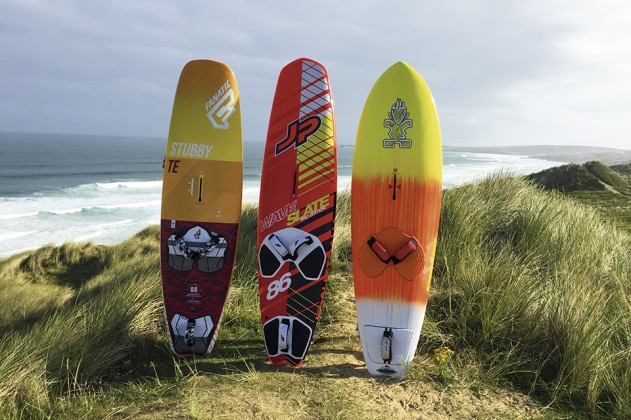NEW TURNING POINT
STUBBY WAVE BOARD TEST 2016
Test Editor Tris Best // Second Testers Maurin Rottenwalter, Joe North
Photos Nick George // Test Location Southwest England
The ‘stubby’ wave board …does it represent a new era in wave board design, or yet another wonderful fad, feeding off (amongst other things…) the frenzied buzz surrounding vanguard surfboard design? We asked the OTC test team to get hold of them as quickly as possible and put them through their paces.
This test was originally published in the October 2015 issue.
Let’s call it what it is – the concept of making the boards short and squat is nothing new in our sport. Prior to the three models on test here hitting the scene, there have been several past designs worthy of note that have been the forbearers of the same virtues. Back in 2004 Naish brought out the Hybrid Wave (214cm / 59cm / 85L) having dabbled in the stubby concept in the speed / slalom discipline with their 89L Hybrid. Robby Naish was the advocate of the project back then, claiming that the inspiration came from his new found love of kitesurfing (we’ll forgive him; he is the King after all!). The fact that you feel so close and connected to the water with so little in front of you led them to experiment with dramatically shortened board lengths. The truth is that the Hybrid Wave was met with mixed reviews. Back then, a length of 214cm felt like a long step away from convention. The board had little stability off the plane (both weight carrying and directional), was difficult to unstick from the water … and even when it was going it wasn’t particularly fast, so struggled to keep up with fast waves or make tight sections unless fully powered. Don’t get us wrong – it was a very bold attempt and Naish should have praise heaped upon them for being visionaries, but for most it was a step too far in an already niche sector of the market.
Fast-forward ten years and wave board design has moved on massively since the introduction of the Hybrid Wave. The accepted design of a conventional wave board has become shorter, wider and thinner. It has been a very steady gradual process of iterative developments over the decade, initiated by Starboard with their Wave Fish, but really exposed and championed with the Evo 74 in 2004.
March on a few years from the Evo, and whilst countless theories have come and gone (and will surely come again!) about deck, rail and bottom shape, probably the single largest revolution in wave board design over the years has been the introduction of multi-fin set-ups. Influenced by prominent characters with distinctive riding styles such as Kauli Seadi, the twinzer exploded onto the scene, followed by the quad, the trailer fin and of course the thruster. In fact, I stand to be corrected, but if you look at every brand’s 2016 wave board line-up there is not a single fin board in sight…
So with all these changes happening since the first board shorter than 220cm, perhaps it was worth another look? Step up the Starboard Black Box in 2013, the Simmer Frugal in 2014 … and here we are in 2016 with many brands at it. Their return has been met with mixed views, even visible emotions. When I first saw signs of the 2016 boards on social media earlier this year, the author of the post posed the same question as the title of this article. What I don’t think he anticipated was the torrent of abuse he copped as a result! Amongst the many replies he received to his ‘stop-press’ posting (many of which can’t be repeated here) there was a message from a dedicated wave-head that I know that feels very strongly about his craft, and will go to great lengths and travel many miles for that “golden session”. His reply was the shortest it could be, but to the point. It simply read …“NO!”
If anything can be gleaned from the remarks from the first sightings, it is this: that the wave sailor is one passionate beast! And much like the discipline itself, it is a question of taste and style. How you interpret the wave – where you lay your path down to the foot of the curve; how tight you turn and vertical you aim back at the lip; and how you project back off as you hit the lip – do you throw the tail, gouge and throw spray or push for an aerial? It all rests with this question of style. Some are more open to change and experimentation, but others are more set in their ways. They know what they like … and like what they know. So if they don’t like the look of something; if it challenges convention, they are not likely to accept it easily. But then again, one thing is for certain – opinions soften over time. And if this new generation of stubby wave board performs … even becomes a more common sight around our shores in the future … opinions may well change.
FINDINGS
So onto the million-dollar question – how do they compare to ‘conventional’ designs? Well, let’s go through some features common amongst these three boards. Firstly, when using any of them, your stance is placed further back on the board, with the back strap right over the top of the fin(s). On the plus side it gives the rider instant response and you can really sense the grip provided. It also means with your weight further back, you don’t dig the nose in during the cutback. The downside to being so far back over the fins is that the stubby board is incredibly sensitive to its fin set-up. Literally half a centimetre can make all the difference to the feel, early planing and response given by the board. Fins have always been critical to performance, but in this style of board we believe it has become even more so. And as for the tow-in of the fins, we think there will be lots of development and discussion about this in the future.
Secondly, the shorter length and more importantly rail length, enables all the boards to carve and fit into tighter wave pockets and sections. Get the balance right on your feet and you’re rewarded with a carve that is so mouth-wateringly smooth and compact that you’ll be left wondering when you suddenly learnt how to sail like a world champion! The downside is that because they need to retain volume somewhere, they all have large noses! A pretty obvious statement I grant you, but something worthy of note. Because, much like the original specialist freestyle boards that appeared back at the turn of the century, these noses are red-hot targets for the front of the boom in the event of a sudden catapult. Sounds silly, but get caught unaware by a sudden gust and you’ll be heading to the board repairers before you know it! You have been warned.
SUMMARY
No need to be verbose about the merits of these boards here. Wave sailing is THE most aspirational discipline of our sport, yet also probably one of, if not the, most niche. Realistically, how many regular wave hunters can afford having two, let alone three, wave boards in their quiver? If any concept is going to take off it has to have wide user appeal … otherwise it will be a non-starter. Providing a chink in the armour to the argument for the stubby, we know that several other brands, such as RRD tried their own versions, but decided against releasing their own on the basis of its ‘all-round’ appeal, using their knowledge of the concept to reach a compromise instead (see the Wave Cult V6 test elsewhere in this issue). And yet … having tested these designs in everything from onshore to cross-offshore conditions, we are pleased to be able to write that we believe 2016 is the year that the stubby concept has come of age.
The Starboard Reactor is the most specialist tool here. It is simply incredible on a wave face, the feeling and drive you get through the rails and fins will add a new dimension to anyone’s riding. The JP has a wider user appeal, being fast and lively and able to tank upwind when powered. It is engaging to sail and will definitely benefit from the user experimenting with the fin / footstrap set up to get the best for their weight and riding style, but it has real world practicality and lays bare the advantages of the modern stubby for all to see. That leaves the Fanatic. In this group it is undoubtedly the most user friendly, with real ‘plug and play’ ease that will surprise most riders that step onto it for the first time. Stable at rest as well as directionally, it gets going early, punches upwind effortlessly and above all is quick. In the turn it has a different feel to a conventional board and will take some dabbling with fin placement to really find what works for you, but with a long waterline through the turn it locks the rail in securely, meaning you can be confident you’ll get to the lip every time.
TEST LOCATION
This test was conducted around the UK shores at more than 6 wave sailing locations. UK conditions can certainly be unpredictable at times, yet with a good summer of wind, we had time to test the boards and sails at a variety of locations and in a mixture of conditions, from cross-onshore to firing cross-off.
uk.otc-windsurf.com
THE LINE-UP


